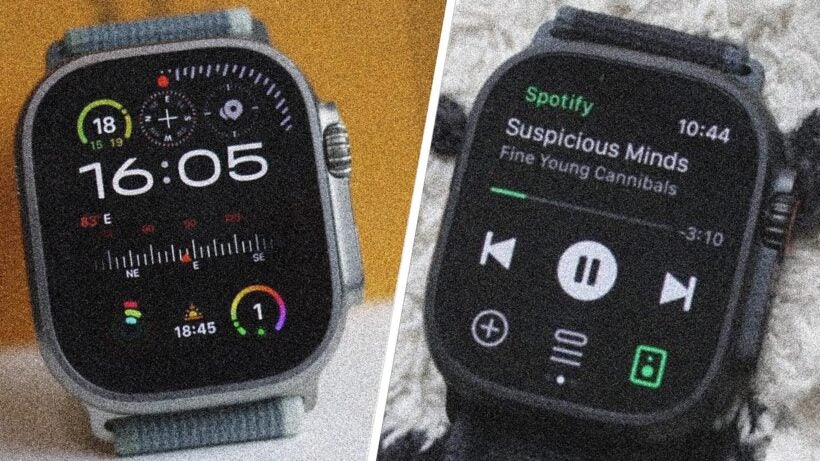Choosing between the Apple Watch Ultra and Ultra 2 can be challenging, and not only because these are two of the best smartwatches money can buy.
In typical Apple fashion, the two generations exhibit few differences. The outward designs are virtually identical; they can run the same software, and the always-on battery life is rated the same.
It’s a big reason, perhaps, why Apple didn’t launch the Ultra 3 in 2024; it’s still working out how to deliver a meaningful change to its premier smartwatch line.
However, despite the overwhelming similarities, there are still a few notable differences between the two Ultra models. We believe that individually, none of these differences are substantial enough to justify upgrading to the Ultra 2 for current users.
Overall, the Ultra 2 is definitely a better choice for first-timers in 2025.
Below, we’ll explain why and detail all the key differences between the two.
Also consider:
- Which Apple Watch? Our recommendations – and which models to avoid
- Apple Watch alternatives: Top options for those with an iPhone
Price overview
The potential price difference is one of the few reasons to consider the original Apple Watch Ultra. If you can still find it in stock, you might be able to save some money.
However, while that may be true, the price is actually one of the main reasons we recommend the Ultra 2 over the OG model. Simply put, Ultra 1 stock is not easy to find. Additionally, even if you do find one, the Ultra 2 is now being discounted as well, which means the price difference isn’t as drastic as it was in 2023 (or early 2024).
If you can find a mega deal on the Ultra 1 using the widgets above, it may still be worth pulling the trigger. However, for the reasons mentioned above and others that we will outline below, the better option at the time of writing is to look for a good Ultra 2 deal.
Design, display, and versions

The Ultra 2 shares the same design language as the original Ultra. Both feature a 49mm case body, identical thickness, and a customizable Action button that isn’t available on any other Apple Watch.
They may look the same, but the Ultra 2’s design has been improved. It’s available in an additional black titanium finish shown below (as well as the OG titanium above) and offers better brightness capacity. The increase to 3,000 nits from the Ultra’s 2000 nits is noticeable and is a nice-to-have feature if you spend a lot of time in direct sunlight.
This improvement also makes the flashlight a little brighter. We don’t often use this feature, so we haven’t noticed a significant difference, but power users will surely appreciate this enhancement in low-light conditions as well.

Regarding those finishes, we don’t have a preference either way, and the durability has remained consistent in our long-term testing. Scratches are slightly more noticeable on the black due to the contrast with the underlying titanium, but this isn’t a significant distinction.
We should also note that the Ultra 2 and Ultra 1 have identical durability specifications. Both can withstand the same depths (40m), are safeguarded against the same level of ingress, and feature the same scratch-resistant glass covering.
They’re both carbon-neutral cases as well, but the carbon offset from manufacturing has changed since the Ultra 1 launch. Pairing either with the latest Trail Loop or Alpine Loop designs makes it carbon neutral. However, it’s not the case if you have the older versions of those bands or the Ocean Band.
Software, smarts, and performance

Given that these are current-gen and last-gen Apple Watch models, they’re still very much within the arc of the annual watchOS updates. However, a couple of key internal differences keep the experience from being identical.
So, while many of the latest updates brought through watchOS 11 are accessible via both Ultra models, the original runs slightly slower (by 30%, according to Apple) because of the S8 chip. The Ultra 2, instead, features the newer S9 variant. This doesn’t manifest as a huge difference in day-to-day use, but it is noticeable when the pair are side by side.
It’s a similar story with storage. The original boasts 32GB, while the Ultra 2 doubles that. It’s not a huge difference for most, we don’t think, but it could be the difference for you if you’re planning to download tons of maps or music for offline use.

Next to that bigger storage is also a new version of the ultrawideband chip, which provides directional feedback if you’re trying to find your Ultra. Again, a potentially huge quality-of-life upgrade if you’re prone to misplacing your watch, even if it’s not a major feature for all.
Then there are the meatier differences in features unlocked by that S9 chip, like the on-watch Siri that can process locally for improved speed and accuracy.
With the newer chip, the Apple Watch Ultra 2 also gains a new double-tap gesture feature.
As shown above, pinching your index finger and thumb activates the accelerometer, gyroscope, and optical heart rate sensor, giving you one-hand control of things like calls or scrolling through the Smart Stack view.
This is also set to expand in the coming years, with watchOS 11 granting third-party developers access to the feature.
Sports and health tracking

The Ultra 1 and 2 provide the same sports tracking experience, whether you prefer trail running, diving, hiking, or any other activity.
The precision dual-frequency GNSS continues to impress us in our long-term testing—showed off in this Chicago Marathon test—and both models are suitable for diving, now with the added ability to save details of your dive data on the dedicated Watch app.
Since watchOS 10, both watches can connect to Bluetooth-enabled cycling sensors for additional metrics such as speed and cadence. Furthermore, watchOS 11 introduces features like Training Load and the ability to pause Activity Rings.
With no new health sensors introduced in the Ultra 2, it’s understandable to think there haven’t been any exclusive upgrades in health tracking. This is mostly accurate—new upgrades have largely been software-based, such as the Vitals app and enhanced pregnancy tracking.
However, sleep apnea notifications introduced in September 2024 are only available on the Ultra 2 because of the newer S9 chip. Other than that, you’ll have an identical experience.
Battery life

If you were hoping for more battery life on the Apple Watch Ultra 2, you’re (mostly) out of luck.
Apple offers the same 36 hours of typical usage in each model, which in real-world testing has generally always translated to around 48-60 hours of medium-heavy use. That’s remained fairly consistent throughout software updates, though the Ultra 2 does it by a fairly indiscernible chunk.
The bigger difference is the power you can expect in the brand’s Low Power Mode. With this mode enabled, the OG Ultra is estimated to only last 60 hours, while the Ultra 2 can achieve 72 hours in the same conditions.
Still, you’re getting the best battery life on an Apple Watch with these models, including the hefty 46mm Apple Watch Series 10.
Verdict: Which should you choose?
While the Apple Watch Ultra 2 might not signify a significant generational leap, there are enough minor upgrades to enhance it as a smartwatch compared to its predecessor.
A brighter screen, increased storage, Double Tap, sleep apnea detection, a slightly longer battery life in Low Power Mode, and an improved Ultra Wideband chip for Find My aren’t necessarily reasons to upgrade. However, they do contribute to making this feel like a different and enhanced experience.
With stock of the original model also hard to come by, it not necessarily being that much cheaper than the Ultra 2 in deals holidays, and software support likely not lasting as long as the Ultra 2, we think this one is a bit of a no-brainer.
However, it’s also true—as we’ve pointed out in our Apple Watch buyer’s guide—that we’re fast approaching the potential arrival of the Ultra 3. We now recommend holding off on the Ultra 2 unless you can find an outstanding deal (or you don’t love the rumored upgrades).




